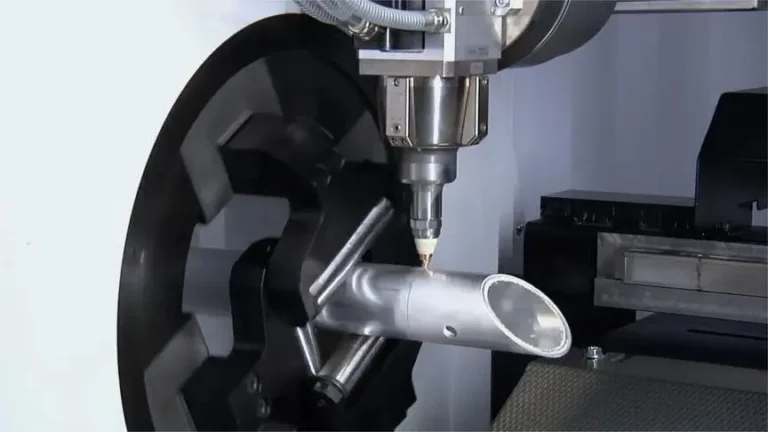Boru kesme makineleri, temiz ve hassas kesimler elde etmek için boru ve boruları kesme veya dilimleme işlemini basitleştiren sanayi sektöründe hayati araçlardır. Bu makineler sadece kesme işlemini daha hızlı ve daha kolay hale getirmekle kalmaz, aynı zamanda iki ana kategoriye ayrılır: soğuk kesme ve sıcak kesme yöntemleri. Güvenlik özellikleri ve havadaki kirlenme olmaması nedeniyle tehlikeli ortamlarda tercih edilen soğuk kesme makineleri, pnömatik ve hidrolik türleri içerirken, gaz, plazma ve lazer kesimi kapsayan sıcak kesme teknikleri, değişen kalınlıktaki malzemeleri verimli bir şekilde dilimlemek için ısıyı kullanır.
Bu kapsamlı kılavuz, taşınabilirlik ve satın alınabilirlik sunan manuel boru kesicilerden, boru lazer kesim makinesi üreticileri tarafından hızları ve hassasiyetleri için aranan gelişmiş lazer boru kesme makinelerine kadar çeşitli boru kesme makinelerini keşfetmeyi amaçlamaktadır.
1. Taşınabilir manuel boru kesici
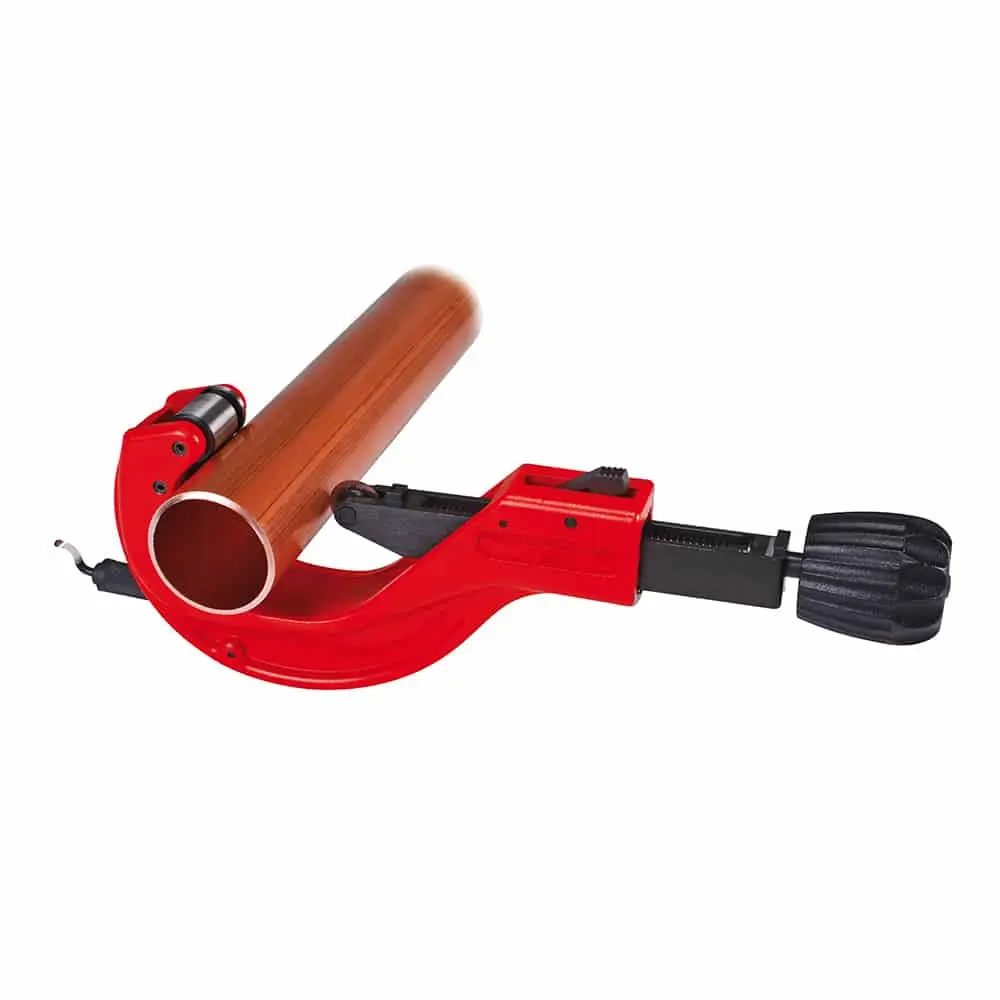
Bir tür soğuk kesim. Portatif manuel boru kesiciler, EMT kanalı, bakır, pirinç, alüminyum ve PVC dahil olmak üzere çeşitli boru türlerini kesmedeki basitlikleri ve etkinlikleri ile ünlüdür. Bu araçlar, taşınabilirliğin önemli olduğu ortamlarda hassasiyetleri ve kullanım kolaylıkları için özellikle değerlidir.
Özellikler
- Tasarım ve Malzemeler: Tipik olarak, bu kesiciler 1/8 inç ila 1 1/8 inç arasında değişen boru çaplarını işlemek üzere tasarlanmıştır. Kompakttırlar ve boruyu sıkıştırmak ve kesiciyi etrafında döndürmek için basit bir işlem içeren manuel işlem gerektirirler.
- Kullanım yöntemi: Temiz bir kesim elde etmek için boru istenen ölçüme göre işaretlenir, kesicinin düğmesi gevşetilir ve boru kesicinin içine yerleştirilir. Kesici tekerleği işaretle hizaladıktan sonra, kullanıcı düğmeyi sıkılaştırır ve kesiciyi borunun etrafında döndürür, kesim tamamlanana kadar düğmeyi kademeli olarak daha da sıkar.
- Kesim Sonrası İşlem: Kesim yapıldıktan sonra, borunun ucundaki çapakları veya dudakları çıkarmak için genellikle kesicinin içine yerleştirilmiş bir çapak alma aleti kullanılır ve pürüzsüz bir yüzey sağlar.
Avantajlar
- Maliyet etkinliği: Daha karmaşık makinelerle karşılaştırıldığında, taşınabilir manuel boru kesiciler nispeten ucuzdur.
- Kullanım Kolaylığı: Basit mekanizmaları, kapsamlı teknik eğitimi olmayan kişiler için bile kullanımlarını kolaylaştırır.
- Güvenlik ve Kompaktlık: Bu aletlerin kullanımı güvenlidir ve elektrikli aletlere kıyasla daha düşük yaralanma riski vardır. Küçük boyutları onları taşımayı ve depolamayı kolaylaştırır.
Sınırlamalar
- Fiziksel Çaba: Kullanımı basit olsalar da, manuel boru kesiciler, büyük ölçekli projeler için ideal olmayabilecek fiziksel çaba gerektirir.
- Malzeme Sınırlamaları: İnce duvarlı borular için en uygun olanlardır. Daha kalın veya daha sert malzemeler daha sağlam kesme çözümleri gerektirebilir.
Taşınabilir manuel boru kesiciler, küçük ölçekli veya hareket halindeyken kesme görevleri için pratik bir çözüm sunar. Maliyeti, rahatlığı ve işlevselliği dengelerler, bu da onları hızlı ve verimli boru kesimi için birçok araç setinde temel bir unsur haline getirir.
2. Daire testere makinası
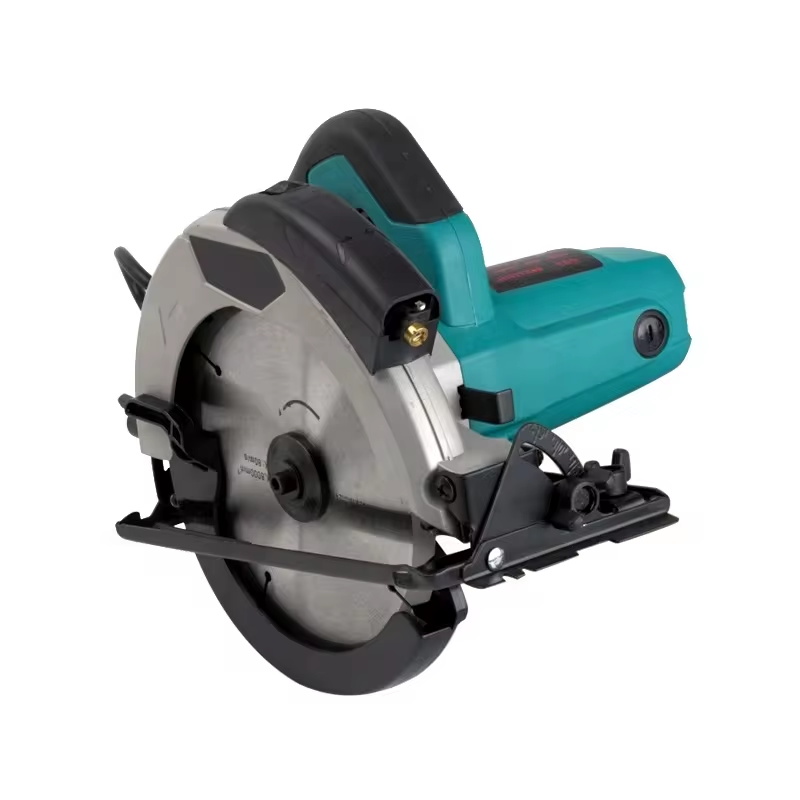
Bir tür soğuk kesim. Daire testere olarak da bilinen daire testere makinesi, öncelikle ahşap, metal ve diğer malzemeleri kesmek için kullanılan bir elektrikli alettir. Daire testere borusu kesme makinesinin çekirdeği, yüksek hızlı dönen bir daire testere bıçağıdır. Bu bıçak, dakikada binlerce devirde dönen güçlü bir elektrik motoru veya benzinli motor tarafından tahrik edilir. Kullanıcı iş parçasını (metal boru gibi) dönen testere bıçağına doğru ittiğinde, bıçak üzerindeki keskin dişler iş parçasını keserek hızlı ve hassas kesim sağlar.
Avantajlar
- Daha düşük Maliyet: Daire testereler için ekipman ve işletme maliyetleri genellikle daha düşüktür.
- Daha Basit Kullanım: Daire testere makinelerinin lazer sistemlerine kıyasla kullanımı ve bakımı daha kolaydır.
- Geliştirilmiş Güvenlik: Dairesel testereler lazer tehlikesi içermez, bu da onları daha güvenli bir seçenek haline getirir.
Sınırlamalar
- Sınırlı Kesme Derinliği: Dairesel testereler, bıçak boyutuna bağlı olarak tipik olarak yaklaşık 2-3 inçlik kesme derinlikleriyle sınırlıdır. Daha kalın veya daha büyük çaplı tüplerle mücadele edebilirler.
- Bıçak Aşınması ve Değiştirilmesi: Daire testere bıçakları zamanla donuklaşacak ve sık sık değiştirilmesi gerekecek ve bu da devam eden bakım maliyetlerini artıracaktır.
- Gürültü ve Titreşim: Dairesel testereler yüksek hızlarda çalışır ve kullanım sırasında operatörler için yorucu olabilecek önemli gürültü ve titreşim üretebilir.
- Çapaklar ve Çapak Oluşumu: Daire testereler temiz kesimler üretebilirken, kesilen yüzeylerde hala bazı çapak veya kenar kusurlarının oluşma potansiyeli vardır.
- Malzeme Sınırlamaları: Dairesel testereler, metaller ve ahşap gibi nispeten homojen malzemelerde düz, doğrusal kesimleri kesmek için en iyi sonucu verir. Karmaşık şekillerle veya oldukça aşındırıcı malzemelerle mücadele edebilirler.
- Operatör Beceri Gereksinimi: Daire testerenin düzgün çalışması, doğru ve güvenli kesimler sağlamak için biraz beceri ve deneyim gerektirir. Yanlış kullanım kazalara veya düşük kesim kalitesine neden olabilir.
- Güvenlik Riskleri: Güvenlik özelliklerine rağmen, dairesel testereler hala operatörün dikkatli bir şekilde dikkatini gerektiren bıçak teması ve geri tepme riskleri sunmaktadır.
3. Pnömatik boru kesme makinası
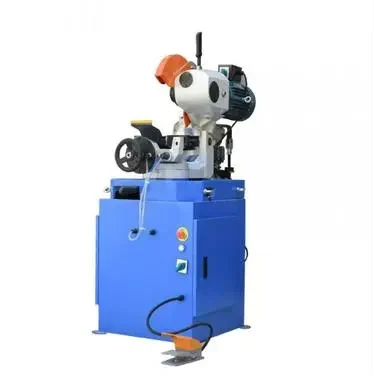
Pnömatik boru kesme makinesi, bir kesme mekanizmasını, tipik olarak dairesel bir testere bıçağını veya kesme aletini boru malzemesinden geçirmek için basınçlı hava veya gazın gücünü kullanır. Basınçlı hava veya gaz, makinenin içindeki bir pnömatik silindire veya pistona verilir, bu daha sonra yerine sıkıca kenetlenmiş olan boruyu kesmek için kesici aleti öne doğru iter. Kesme hareketi, basınçlı hava veya gaz akışının düzenlenmesiyle kontrol edilir ve makine, operatörü korumak için güvenlik özellikleriyle tasarlanmıştır. Pnömatik kesim aynı zamanda bir tür soğuk kesimdir.
Avantajlar
- Kompakt tasarım: Elektrik motoru olmadığı için makine küçülür ve dar alanlarda kullanılabilir.
- Çok Yönlü Kesim: Kesme mekanizmasını ayarlayarak çeşitli boru malzemelerini ve boyutlarını işleyebilir.
- Kontrollü Kesim: Pnömatik güç, hassas ve temiz kesimler için düzgün, kademeli bir kesme kuvveti sağlar.
- Gelişmiş Güvenlik: Operatörü korumak için korumalar ve otomatik kapanma gibi güvenlik özelliklerini içerir.
- Kolay Bakım: Daha az elektrikli bileşene sahip daha basit tasarım, servis ve bakımı kolaylaştırır.
- Uygun Maliyetli: Pnömatik güç kaynağı genellikle elektrikle çalışan bir boru kesiciden daha uygun maliyetlidir.
- Çok Yönlü Kesim: Çok çeşitli boru malzemelerini, boyutlarını ve kalınlıklarını işleyebilir.
- Gelişmiş Güvenlik: Dahili güvenlik özellikleri, kullanım sırasında operatörü korur.
- Tehlikeli Alanlar için uygundur: Patlama veya yangın riski olan ortamlarda kullanımı güvenlidir.
Sınırlamalar
- Sınırlı Güç: Elektrikli modellere kıyasla çok kalın duvarlı veya sert metal borularla mücadele edebilir.
- Hava / Gaz Bağımlılığı: Çalışması için sabit bir basınçlı hava veya gaz kaynağı gerektirir ve hareketliliği sınırlar.
- Daha Yavaş Kesme Hızı: Genellikle elektrikli testerelere göre daha düşük kesme hızına sahiptir ve üretkenliği azaltır.
- Gürültü ve Titreşim: Pnömatik çalışma, kullanım sırasında daha fazla gürültü ve titreşim üretebilir.
- Potansiyel Hava Sızıntıları: Pnömatik bileşenler zamanla hava sızıntılarına eğilimli olabilir ve performansı etkileyebilir.
- Kesme Derinliği Sınırlamaları: Tipik olarak yaklaşık 2-3 inçlik kesme derinlikleriyle sınırlıdır.
- Bakım Gereksinimleri: Daha basit olmasına rağmen, hava sisteminin hala düzenli bakıma ihtiyacı vardır.
4. Manyetik boru kesme makinası
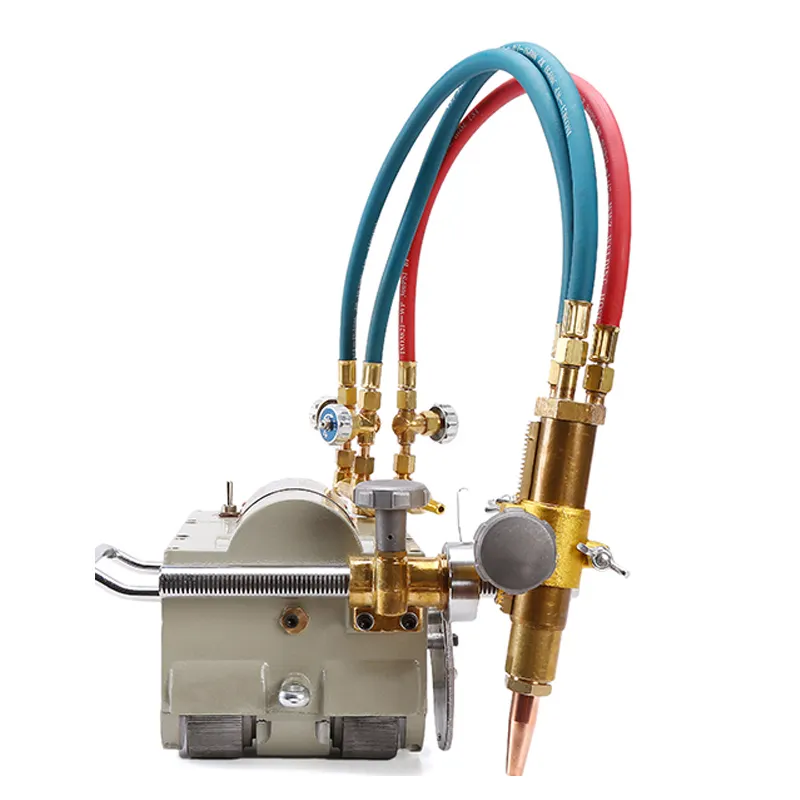
Manyetik boru kesme makineleri, petrol, petrokimya, gemi yapımı, enerji üretimi ve inşaat tesisat endüstrilerindeki fabrikalarda ve işletmelerde çeşitli dikişsiz çelik boruların kesilmesi ve eğilmesi için uygundur. Bu makine, bir tahrik mekanizmasını kesmek için çelik borunun etrafında otomatik olarak hareket eden iki takım dört kalıcı manyetik tekerleğe sahiptir. Kesme işlemi, bir oksijen-asetilen alevi veya bir oksijen-propan alevi kullanabilir. 108 mm veya üzeri çapa sahip çeşitli özelliklerde dikişsiz çelik boruları kesmek ve eğmek için kullanılabilir.
Avantajlar
- Düşük fiyat: Manyetik boru kesme makinesinin yapısı karmaşık değildir ve üretim maliyeti düşüktür.
- Basit ve kullanışlı montaj: Manyetik boru kesme makinesinin birkaç montaj parçası vardır, hızlı bir şekilde kurulabilir ve kullanılabilir ve her yere taşınabilir.
- Büyük kesme açısı: Kesme açısı yatay, dikey ve yukarı doğru kesilecek şekilde esnek bir şekilde ayarlanabilir. Eğimli kesimi destekler.
- Temassız Kesim: Kesim, herhangi bir fiziksel alet teması olmadan yapılır ve tüp hasarı veya deformasyon riskini ortadan kaldırır. Bu özellikle ince duvarlı veya hassas borular için faydalıdır.
Sınırlamalar
- Malzeme Sınırlamaları: Manyetik olmayan metalleri değil, sadece çelik gibi ferromanyetik malzemeleri işleyebilir.
- Boyut Sınırlamaları: Tüp boyutunun ve kalınlığının etkili bir şekilde kenetlenebilecek sınırları vardır.
- Yüksek Güç Tüketimi: Elektromanyetik sıkıştırma önemli elektrik gücü gerektirir.
- Potansiyel Girişim: Güçlü manyetik alanlar yakındaki elektronik ekipmanı bozabilir.
- Bakım İhtiyaçları: Elektromanyetik bileşenler hala periyodik bakım gerektirir.
- Daha yüksek başlangıç Maliyeti: Manyetik boru kesiciler, diğer bazı seçeneklere kıyasla daha yüksek bir ön yatırıma sahiptir.
- Kesme Derinliği Kısıtlamaları: Tipik olarak yaklaşık 2-3 inç kesme derinlikleri ile sınırlıdır.
5. Plazma tüp kesme makinası
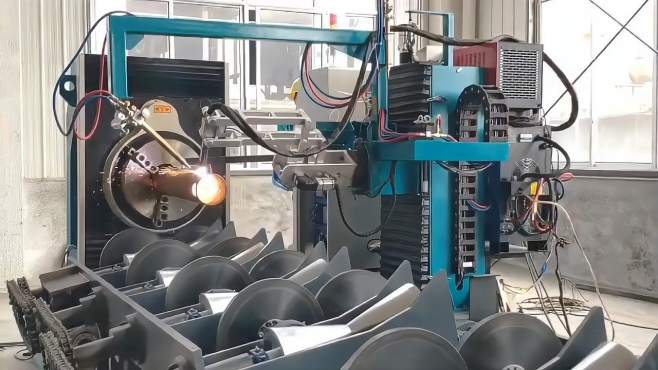
Plazma boru kesme makineleri, metalleri olağanüstü hız ve hassasiyetle dilimlemek için plazma olarak bilinen yüksek hızlı bir iyonize gaz akışından yararlanır. 40.000 Fahrenheit dereceye kadar sıcaklıklara ulaşabilen bir plazma arkı üreterek çalışır. Bu yoğun ısı, metali kesme yerinde eritirken, yüksek hızlı bir gaz jeti erimiş metali dışarı atarak hassas bir kesme yuvası oluşturur.
Avantajlar
- Malzeme Çok Yönlülüğü: Plazma kesiciler, çelik, alüminyum ve daha fazlası dahil olmak üzere çok çeşitli iletken metalleri kesmede ustadır.
- Kalınlık Kapasitesi: Plazma kesiciler, lazer kesicilerin tipik 19 mm sınırından önemli ölçüde daha büyük olan 38 mm'ye kadar metal kalınlıklarını işleyebilir.
- CNC Entegrasyonu: CNC teknolojisini kullanan plazma kesiciler, hassasiyeti artıran ve insan hatası olasılığını azaltan otomatik, programlanabilir kesme işlemleri gerçekleştirebilir.
- Maliyet etkinliği: Plazma kesiciler genellikle lazer kesicilere kıyasla daha düşük başlangıç yatırımı ve işletme maliyetleri gerektirir.
- Özelleştirme ve Verimlilik: Plazma makineleri, işçilik bağımlılığının azalmasına ve genel güvenliğin iyileştirilmesine yol açabilecek yüksek düzeyde hassasiyet ve malzeme optimizasyonu sunar.
- Geniş Malzeme Uyumluluğu: Lazer kesicilerin aksine, plazma makineleri metallerin yansıtıcı özelliklerinden etkilenmez ve daha geniş bir malzeme yelpazesinin etkili bir şekilde kesilmesine izin verir.
Sınırlamalar
- Malzeme Sınırlamaları: İletken olmayan malzemeler için değil, esas olarak çelik ve alüminyum gibi iletken malzemeler için etkilidir.
- Kalınlık Sınırlamaları: Etkili bir şekilde kesilebilecek maksimum boru kalınlığı üzerinde kısıtlamaları vardır.
- Cüruf Oluşumu: Kesilen yüzeylerde erimiş metal artıkları birikerek ekstra son işlem gerektirebilir.
- Yüksek Enerji Tüketimi: Plazma kesme işlemi, işletme maliyetlerini artırarak önemli elektrik gücü gerektirir.
- Gürültü ve Duman Sorunları: Çalışma sırasında yüksek perdeli gürültü ve potansiyel olarak zararlı dumanlar üretir.
- Kirliliklere Duyarlılık: Performans, tüp yüzeyindeki kirleticilerden etkilenebilir.
- Yüzey Kalitesi: Kesme yüzeyi, lazer kesim gibi diğer yöntemlere kıyasla daha düşük kesme hassasiyeti ve daha fazla cüruf ile daha az pürüzsüz olabilir.
- Güvenlik Önlemleri: Plazma kesicilerin çalışması, operatörleri korumak için sıkı güvenlik protokolleri gerektiren zararlı gazlar ve yoğun ark ışığı üretir.
- Bakım: Daha büyük kesme yuvasını yönetmek ve kesme bıçaklarının uzun ömürlülüğünü ve etkinliğini sağlamak için düzenli bakım gereklidir.
6. Lazer tüp kesme makinesi

Lazer boru kesme makinesinin şu anda piyasadaki en hızlı büyüyen boru kesme ekipmanı olduğuna şüphe yok. Lazer boru kesme makineleri, endüstriyel üretimde sürekli artan talebi karşılayabilmekte ve performansta önemli avantajlara sahiptir, bu da onları boru işleme alanında yaygın olarak popüler kılmaktadır.
Avantajlar
- Daha Yüksek Hassasiyet: Lazer kesim, geleneksel testerelere veya plazmaya göre çok daha ince, daha temiz kesim kenarları sağlar.
- Daha Hızlı Kesme Hızı: Lazerle kesme, üretim verimini artıran son derece hızlı bir işlemdir.
- Temassız Kesim: Özellikle ince veya hassas borular için hasarı önlemek için fiziksel takım temasını önler.
- Geliştirilmiş Otomasyon: Daha fazla verimlilik için tam otomatik CNC programlı çalışmayı sağlar.
- Çok yönlülük: Geleneksel yöntemlerin mücadele ettiği sert alaşımlar da dahil olmak üzere daha geniş bir boru malzemesi yelpazesini kesebilir.
- Çevresel Faydalar: Lazer kesim, daha düşük enerji kullanımı ile temiz, düşük emisyonlu bir işlemdir.
Sınırlamalar
- Daha Yüksek Maliyetler: Geleneksel boru kesicilere kıyasla daha yüksek ön sermaye yatırımı ve devam eden işletme giderleri.
- Kalınlık Sınırlamaları: İnce ila orta kalınlıkta borular için en uygun, çok kalın duvarlı borularla mücadele eder.
- Güvenlik Riskleri: Yüksek güçlü lazerler, sağlam güvenlik önlemleri ve özel operatör eğitimi gerektirir.
- Yoğun Bakım: Hassas bileşenlerin kesim kalitesini korumak için düzenli ve titiz bakıma ihtiyacı vardır.
- Malzeme Kısıtlamaları: Yüksek oranda yansıtıcı veya ısıya dayanıklı boru malzemeleri için uygun olmayabilir.
Tablo: Geleneksel ve Lazer Tüp Kesiminin Karşılaştırılması
| Özellik | Geleneksel Kesim Yöntemleri | Lazer Tüp Kesme Makinesi |
|---|---|---|
| Hassasiyet | Düşük | Yüksek |
| Hız | Ölçülü | Yüksek |
| Malzeme Atıkları | Daha yukarı | Minimum |
| Zaman İçindeki Maliyet | Daha yüksek bakım maliyetleri | Daha düşük bakım maliyetleri |
| Esneklik | Sınırlı | Yüksek |
| Güvenlik | Ölçülü | Geliştirilmiş |
Çok yönlülük ve Kişiselleştirme
Lazer tüp kesme makineleri, farklı malzemeler için farklı aletler gerektirebilecek geleneksel yöntemlerin aksine, belirli malzeme türlerini veya kalınlıkları kesmekle sınırlı değildir. Bu makineler, diğer yöntemlerle zorlayıcı olabilecek karmaşık geometrileri ve desenleri işleyebilen özelleştirmede mükemmeldir. İnce ve kalın duvarlı boruları kesme yetenekleri, çok yönlülüklerine katkıda bulunur ve bu da onları çok çeşitli uygulamalar için uygun hale getirir.
Güvenlik ve Çevresel Hususlar
Lazer kesim, geleneksel yöntemlere kıyasla genellikle daha güvenli ve daha çevre dostudur. İşlem, sıvıların veya yağlayıcıların kesilmesini gerektirmez, atık üretimini ve potansiyel tehlikeleri azaltır. Lazer tüp kesiminin bu yönü, çevresel etki ve güvenliğin büyük endişe kaynağı olduğu endüstrilerde özellikle önemlidir.
Ekonomik ve Operasyonel Avantajlar
Lazer tüp kesimine yapılan ilk kurulum ve yatırım geleneksel yöntemlerden daha yüksek olsa da, uzun vadeli faydalar arasında daha düşük bakım gereksinimleri ve ikincil son işlemlere olan ihtiyacın azaltılması yer alır. Bu faktörler zaman içinde daha uygun maliyetli bir çözüme katkıda bulunur. Ek olarak, otomasyon ve yazılımın entegrasyonu operasyonel verimliliği artırarak işçilik maliyetlerini daha da düşürür ve çıktı kalitesini artırır.
Lazer tüp kesme makineleri, modern üretimin artan taleplerini karşılamak için en son teknolojiyi entegre ederek gelişmeye devam ediyor. Hassas, verimli ve çok yönlü kesim çözümleri sunma yetenekleri, onları sanayi sektöründe vazgeçilmez bir araç haline getirir.
7. Karşılaştırmalı Değerlendirme
Endüstriyel boru kesimi alanında, doğru makineyi seçmek, çeşitli kesme teknolojilerinin farklı yeteneklerini ve sınırlamalarını anlamaya bağlıdır. Bu karşılaştırmalı değerlendirme, lazer kesicilerin, plazma kesicilerin ve soğuk kesme makinelerinin özelliklerini inceleyerek, operasyonel farklılıkları ve farklı endüstriyel ihtiyaçlara uygunluğu hakkında net bir bakış açısı sağlar.
Lazer Kesiciler ve Plazma Kesiciler
Hassasiyet ve Malzeme Kalınlığı
Lazer kesiciler, daha küçük bir çentik elde edebilen ve minimum kalıntı bırakabilen olağanüstü hassasiyetleriyle kutlanır. Bu, onları temiz kesimlerin en önemli olduğu hassas işler ve hassas gravür için ideal kılar. Bununla birlikte, genellikle 19 mm kalınlığa kadar olan malzemeleri işlerler, ancak daha güçlü modeller daha kalın alt tabakaları yönetebilir.
Tersine, plazma kesiciler, 38 mm kalınlığa kadar olan malzemeleri verimli bir şekilde keserek malzeme kalınlığında daha fazla çok yönlülük sunar. Bu özellik, plazma kesicileri malzeme kalınlığının değiştiği daha geniş bir endüstriyel uygulama yelpazesi için uygun hale getirir.
Maliyet Hususları
Finansal açıdan bakıldığında, plazma kesiciler tipik olarak daha düşük bir başlangıç yatırımı gerektirir ve çalıştırılması daha ucuzdur. Bu maliyet etkinliği, plazma kesicileri, başlangıç maliyetlerini en aza indirmek isteyen işletmeler için cazip bir seçenek haline getirir.
Güvenlik ve Çevresel Etki
Her iki kesme teknolojisi de duman ve diğer tehlikeli yan ürünlerin üretimi nedeniyle sıkı güvenlik önlemleri gerektirir. Özellikle plazma kesimi, operatör sağlığını korumak için sağlam havalandırma sistemleri ve koruyucu donanım gerektiren dumanlar, kıvılcımlar ve radyasyon üretir. Benzer şekilde, lazer kesiciler yoğun ısı ve potansiyel olarak zararlı lazer emisyonları üreterek uygun güvenlik ekipmanı ve eğitimine duyulan ihtiyacı vurgular.
Soğuk Kesme Makineleri: Güvenlik ve Taşınabilirlik
Isı ve kıvılcımları önleyen bir teknik kullanan soğuk kesme makineleri, hidrokarbon işleme gibi tehlikeli ortamlarda özellikle avantajlıdır. Bu makineler sadece daha güvenli değil, aynı zamanda daha ekonomiktir ve karmaşık güvenlik önlemlerine ve pahalı ekipmanlara olan ihtiyacı azaltır.
Taşınabilirlik ve Dayanıklılık
Soğuk kesiciler taşınabilir, dayanıklı, hafif ve kompakt olacak şekilde tasarlanmıştır, bu da onları ekipman hareketliliğinin çok önemli olduğu yerinde işler için ideal kılar. Bu taşınabilirlik, etkili boru kesimi için gereken hassasiyeti hala sundukları için performanslarından ödün vermez.
Doğru makineyi Seçmek
Bir boru kesme makinesi seçerken, birkaç faktör dikkate alınmalıdır:
- Malzeme Türü ve Kalınlığı: Kesilecek malzemenin ve kalınlığının lazer kesicinin, plazma kesicinin veya soğuk kesicinin yetenekleriyle aynı hizada olup olmadığını değerlendirin.
- Hassasiyet İhtiyaçları: Görev için gereken hassasiyet düzeyini belirleyin. Yüksek hassasiyetli kesimler için bir lazer kesici gerekli olabilirken, plazma kesiciler daha az zorlu hassas işler için uygundur.
- Operasyonel Ortam: Operasyonel ortamı göz önünde bulundurun. Tehlikeli bölgelerde soğuk kesiciler daha güvenli bir alternatif sunar.
- Maliyet Etkinliği: Bakım ve işletme maliyetleri de dahil olmak üzere bütçe kısıtlamalarını ve toplam sahip olma maliyetini değerlendirin. Bütçeye duyarlı operasyonlar için plazma kesiciler tercih edilebilir.
Tablo: Kesme Teknolojilerine Karşılaştırmalı Genel Bakış
| Özellik | Lazer Kesici | Plazma Kesici | Soğuk Kesici |
|---|---|---|---|
| Hassasiyet | Yüksek | Ölçülü | Ölçülü |
| Malzeme Kalınlığı | 19 mm'ye kadar (güçlü modellerle daha yüksek) | 38 mm'ye kadar | Değişir |
| Maliyet | Daha yüksek başlangıç ve işletme maliyetleri | Daha düşük başlangıç ve işletme maliyetleri | Ekonomik |
| Güvenlik | Yüksek ısı, göz hasarı riski | Dumanlar, kıvılcımlar, radyasyon | Daha güvenli, kıvılcım veya ısı yok |
| Uygunluk | Hassas görevler, gravür | Çok yönlü malzeme kalınlığı | Tehlikeli ortamlar |
Bu karşılaştırmalı analiz, kesme makinesinin yeteneklerini eldeki endüstriyel görevlerin özel gereksinimleriyle eşleştirmenin, operasyonlarda hem verimliliği hem de güvenliği sağlamanın öneminin altını çizmektedir.
8. Sonuç
Çeşitli boru kesme makinelerinin araştırılmasıyla, uygun bir kesici takım seçiminin hassasiyet, malzeme kalınlığı, çalışma ortamı ve maliyet hususları dengesine bağlı olduğu açıktır. Çok yönlü pnömatik ve manyetik boru kesicilerden gelişmiş lazer ve plazma modellerine kadar her makine, belirli endüstriyel uygulamalara uyarlanmış benzersiz avantajlar sunar. Bu kılavuz, karar verme sürecine yardımcı olmak için karşılaştırmalı bir içgörü sağlayarak, verimli, güvenli ve uygun maliyetli operasyonlar için en uygun kesim çözümünün seçilmesini sağlayarak bu farklılıkları tanımlamıştır.
